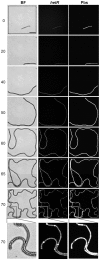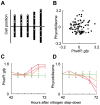Cyanobacterial cell lineage analysis of the spatiotemporal hetR expression profile during heterocyst pattern formation in Anabaena sp. PCC 7120
- PMID: 19823574
- PMCID: PMC2756587
- DOI: 10.1371/journal.pone.0007371
Cyanobacterial cell lineage analysis of the spatiotemporal hetR expression profile during heterocyst pattern formation in Anabaena sp. PCC 7120
Abstract
Diazotrophic heterocyst formation in the filamentous cyanobacterium, Anabaena sp. PCC 7120, is one of the simplest pattern formations known to occur in cell differentiation. Most previous studies on heterocyst patterning were based on statistical analysis using cells collected or observed at different times from a liquid culture, which would mask stochastic fluctuations affecting the process of pattern formation dynamics in a single bacterial filament. In order to analyze the spatiotemporal dynamics of heterocyst formation at the single filament level, here we developed a culture system to monitor simultaneously bacterial development, gene expression, and phycobilisome fluorescence. We also developed micro-liquid chamber arrays to analyze multiple Anabaena filaments at the same time. Cell lineage analyses demonstrated that the initial distributions of hetR::gfp and phycobilisome fluorescence signals at nitrogen step-down were not correlated with the resulting distribution of developed heterocysts. Time-lapse observations also revealed a dynamic hetR expression profile at the single-filament level, including transient upregulation accompanying cell division, which did not always lead to heterocyst development. In addition, some cells differentiated into heterocysts without cell division after nitrogen step-down, suggesting that cell division in the mother cells is not an essential requirement for heterocyst differentiation.
Conflict of interest statement
Figures



Similar articles
-
cyAbrB Transcriptional Regulators as Safety Devices To Inhibit Heterocyst Differentiation in Anabaena sp. Strain PCC 7120.J Bacteriol. 2019 Aug 8;201(17):e00244-19. doi: 10.1128/JB.00244-19. Print 2019 Sep 1. J Bacteriol. 2019. PMID: 31085690 Free PMC article.
-
hetR and patS, two genes necessary for heterocyst pattern formation, are widespread in filamentous nonheterocyst-forming cyanobacteria.Microbiology (Reading). 2009 May;155(Pt 5):1418-1426. doi: 10.1099/mic.0.027540-0. Epub 2009 Apr 21. Microbiology (Reading). 2009. PMID: 19383713
-
The heterocyst-specific NsiR1 small RNA is an early marker of cell differentiation in cyanobacterial filaments.mBio. 2014 May 13;5(3):e01079-14. doi: 10.1128/mBio.01079-14. mBio. 2014. PMID: 24825011 Free PMC article.
-
The Making of a Heterocyst in Cyanobacteria.Annu Rev Microbiol. 2022 Sep 8;76:597-618. doi: 10.1146/annurev-micro-041320-093442. Epub 2022 Jun 7. Annu Rev Microbiol. 2022. PMID: 35671534 Review.
-
Molecular circuit of heterocyst differentiation in cyanobacteria.J Basic Microbiol. 2020 Sep;60(9):738-745. doi: 10.1002/jobm.202000266. Epub 2020 Jun 9. J Basic Microbiol. 2020. PMID: 32515850 Review.
Cited by
-
Functional Dissection of Genes Encoding DNA Polymerases Based on Conditional Mutants in the Heterocyst-Forming Cyanobacterium Anabaena PCC 7120.Front Microbiol. 2020 Jun 3;11:1108. doi: 10.3389/fmicb.2020.01108. eCollection 2020. Front Microbiol. 2020. PMID: 32582078 Free PMC article.
-
Live-cell imaging of cyanobacteria.Photosynth Res. 2015 Oct;126(1):33-46. doi: 10.1007/s11120-014-0049-x. Epub 2014 Nov 4. Photosynth Res. 2015. PMID: 25366827 Review.
-
Position-dependent changes in phycobilisome abundance in multicellular cyanobacterial filaments revealed by Raman spectral analysis.MicroPubl Biol. 2023 May 1;2023:10.17912/micropub.biology.000799. doi: 10.17912/micropub.biology.000799. eCollection 2023. MicroPubl Biol. 2023. PMID: 38584724 Free PMC article.
-
Formation and maintenance of nitrogen-fixing cell patterns in filamentous cyanobacteria.Proc Natl Acad Sci U S A. 2016 May 31;113(22):6218-23. doi: 10.1073/pnas.1524383113. Epub 2016 May 9. Proc Natl Acad Sci U S A. 2016. PMID: 27162328 Free PMC article.
-
cyAbrB Transcriptional Regulators as Safety Devices To Inhibit Heterocyst Differentiation in Anabaena sp. Strain PCC 7120.J Bacteriol. 2019 Aug 8;201(17):e00244-19. doi: 10.1128/JB.00244-19. Print 2019 Sep 1. J Bacteriol. 2019. PMID: 31085690 Free PMC article.
References
-
- Golden JW, Yoon HS. Heterocyst development in Anabaena. Curr Opin Microbiol. 2003;6:557–563. - PubMed
-
- Zhang CC, Laurent S, Sakr S, Peng L, Bedu S. Heterocyst differentiation and pattern formation in cyanobacteria: a chorus of signals. Mol Microbiol. 2006;59:367–375. - PubMed
-
- Haselkorn R. Cell–cell communication in filamentous cyanobacteria. Mol Microbiol. 2008;70:783–785. - PubMed
Publication types
MeSH terms
Substances
LinkOut - more resources
Full Text Sources

